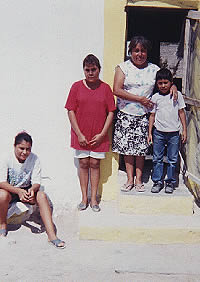
Candelillera Maria Orozco (standing
in doorway) worked from age 10 alongside her father,
then worked with her husband. The family lived in brush
shelters called "jacalitas" or in caves in
the mountains while harvesting candelilla away from
home. Her children, Julia (seated), Veronica (red shirt),
and Chuy do not work with candelilla. Las Norias, Coahuila,
Mexico. Photo by JoAnn Pospisil. Click to enlarge.
|
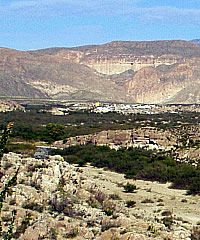
The small town of Boquillas, nestled
at the foot of the Sierra del Carmens, was at one time
a critical port of entry. Today, due to NAFTA and security
measures, the border crossing has been closed and the
historic river ferry has ceased operations. Photo by
Susan Dial. Click to enlarge.
|
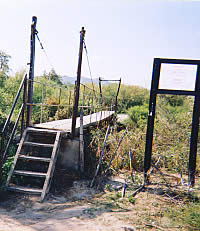
Candelária, Texas. Footbridge
over the Rio Grande to the village of San Antonio del
Bravo, Chihuahua, Mexico. The sign to the right warns
that it is illegal to enter the United States at this
point. This informal crossing was in use for thousands
of years before it was closed by the U.S. government
in 1996. Photo by JoAnn Pospisil. Click to enlarge.
|
|
The economic and cultural manifestations of the
candelilleros' proud traditions have withstood past
market assaults and, despite an uncertain future, the
candelilla wax industry remains an important economic
mainstay unique to the Big Bend region.
|
|
Curtis Tunnell visited some of the riverside
camps during initial survey and study of the candelilla wax
industry and observed in his 1981 report that "there
is a conspicuous absence of women." However, in subsequent
research, I have found that women often participated in the
industry, and these female candelilleras harvested
and processed candelilla alongside their fathers, grandfathers,
brothers and husbands. There is no stigma attached to female
participation although the form and extent varies according
to local custom.
Some candelillera tasks include harvesting,
handling the burros in camp and during candelilla transport,
cooking food for the crew, carrying water to fill the processing
vat, stomping the candelilla to pack it tightly in the vat,
skimming wax, and removing the spent plant from the vat and
stacking this yerba seca [literally, dried herb] away
from the processing area. Candelilleras generally are
strong-willed, stoic, and somewhat non-conformist with a love
of the outdoors. The likelihood of violent confrontations
with forestales probably accounts for the absence of
women in camps near the river.
Historically, field processed candelilla wax,
called cerote, was sold legally into the U. S. anywhere
along the Rio Grande to American buyers who generally paid
higher prices and in cash. The wax then was declared as soon
as possible at a formal port of entry. Both candelilleros
and U. S. buyers recount colorful incidents related to this
"direct" import across the Rio Grande which clashed
in mid-river with Mexican export restrictions that required
all wax to be sold through the Mexican National Bank.
In the 1990s the North American Free Trade Agreement
[NAFTA] eroded the independent production supported and encouraged
by the ejido system. NAFTA privatized the industry
which caused more centralization and increasing control by
large commercial interests. In 1996 all Class B informal Rio
Grande border crossings were closed by the U. S. government.
Candelilleros in northern Mexican villages like Manuel
Benavides [San Carlos], Boquillas, Jaboncillos and Las Norias
found their small profit margin could not support transporting
the wax to the relatively distant formal ports of entry at
Presidio and Del Rio [see map]. These imposed market conditions
forced the independent producers to sell their cerote to local
Mexican buyers.
The generally lax enforcement of the 1996 Class
B crossing closings ended following September 11, 2001. Presidio
and Del Rio then in reality became the only legal entry points
in the Big Bend region. This caused crucial tourist dollars
to vanish from the economies of border villages like Boquillas,
Santa Elena, and Paso Lajitas. Candelilla harvesting and wax
production escalated because the candellilla wax trade became
critical as the remaining legal means for participation in
a cash economy. Other alternatives for replacing lost tourist
dollars are not acceptable to most citizens. One option is
the costly special work permit for U. S. employment along
the border, perhaps in the expanding Lajitas resort. Another
more lucrative but illegal and dangerous choice is drug trafficking.
Today most cerote is sold to Mexican
buyers and warehoused in Mexico. Larger lots then are exported
to U. S. buyers/brokers through Presidio or Del Rio, or directly
to commercial consumers in the northeastern U. S., or to newly
developed markets in Germany and Japan. Current prices are
considerably higher than historically and often not competitive
for U. S. buyers. For the past three years, Mexican buyers
in the State of Chihuahua paid candelilleros 27 pesos [minus
3 pesos for social services] per kilogram, almost $6 per pound
at the exchange rate of 10 pesos per U. S. dollar.
With proper management, candelilla is a renewable
natural resource with myriad uses in our everyday lives [see
chart]. Candelilla's conservation and managed commercial exploitation
is becoming increasingly important as the population continues
to swell along the northern Mexican border, and survival in
this arid environment with its paucity of resources becomes
ever more tentative. The economic and cultural manifestations
of the candelilleros' proud traditions have withstood
past market assaults and, despite an uncertain future, the
candelilla wax industry remains an important economic mainstay
unique to the Big Bend region.
|
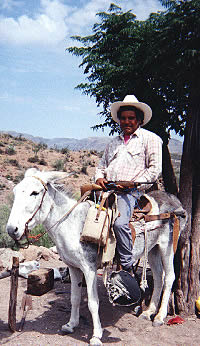
Candelillero Navidad Zubía
on his mule. This hardy animal remains the most reliable
form of transportation for hauling harvested candelilla
from steep terrain in remote mountain areas. San Carlos
Chihuahua, Mexico. Photo by JoAnn Pospisil. Click to
enlarge.
|
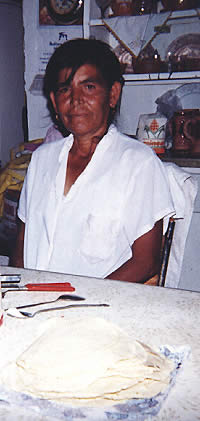
At age 13, candelillera Flora Zubía
Guevera began working candelilla with her father and
brothers. When they were working for another rancher,
the entire family sometimes camped out for three or
four nights while completing the job. Later she also
worked candelilla alongside her husband. Photo taken
near San Carlos, Chihuahua, Mexico, by JoAnn Pospisil.
|
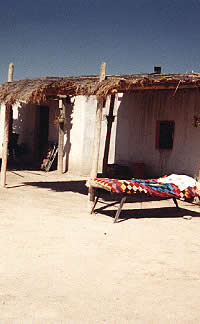
Cool evening breezes are easier to
enjoy outdoors. The colorful and durable "cubre
de cama" (bed cover or quilt) is made from polyester.
One man insists that all the polyester pantsuits from
the 1960s and 1970s found their way to northern Mexico
where they provide bright, almost indestructible quilting
material. Jaboncillos, Coahuila, Mexico. Photo by JoAnn
Pospisil. Click to enlarge.
|
|